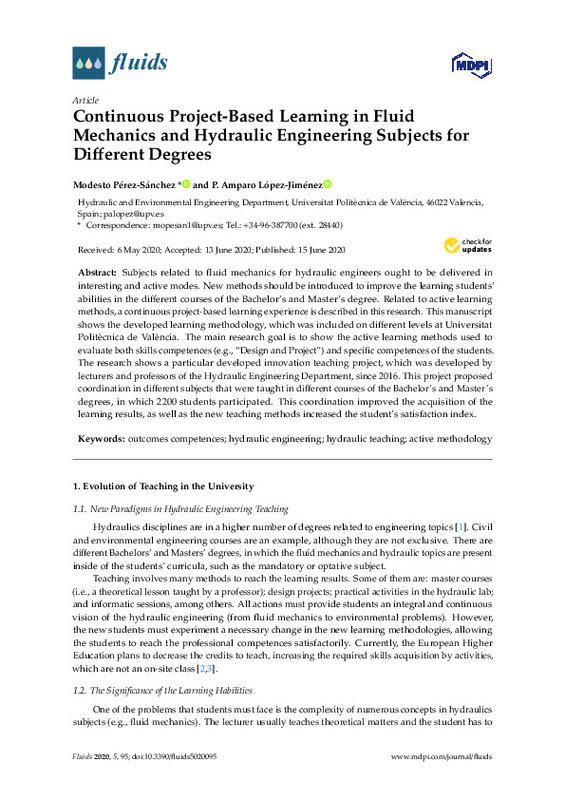JavaScript is disabled for your browser. Some features of this site may not work without it.
Buscar en RiuNet
Listar
Mi cuenta
Estadísticas
Ayuda RiuNet
Admin. UPV
Continuous Project-Based Learning in Fluid Mechanics and Hydraulic Engineering Subjects for Different Degrees
Mostrar el registro sencillo del ítem
Ficheros en el ítem
| dc.contributor.author | Pérez-Sánchez, Modesto
|
es_ES |
| dc.contributor.author | López Jiménez, Petra Amparo
|
es_ES |
| dc.date.accessioned | 2021-02-13T04:31:49Z | |
| dc.date.available | 2021-02-13T04:31:49Z | |
| dc.date.issued | 2020-06 | es_ES |
| dc.identifier.uri | http://hdl.handle.net/10251/161201 | |
| dc.description.abstract | [EN] Subjects related to fluid mechanics for hydraulic engineers ought to be delivered in interesting and active modes. New methods should be introduced to improve the learning students' abilities in the different courses of the Bachelor's and Master's degree. Related to active learning methods, a continuous project-based learning experience is described in this research. This manuscript shows the developed learning methodology, which was included on different levels at Universitat Politecnica de Valencia. The main research goal is to show the active learning methods used to evaluate both skills competences (e.g., "Design and Project") and specific competences of the students. The research shows a particular developed innovation teaching project, which was developed by lecturers and professors of the Hydraulic Engineering Department, since 2016. This project proposed coordination in different subjects that were taught in different courses of the Bachelor's and Master's degrees, in which 2200 students participated. This coordination improved the acquisition of the learning results, as well as the new teaching methods increased the student's satisfaction index. | es_ES |
| dc.language | Inglés | es_ES |
| dc.publisher | MDPI AG | es_ES |
| dc.relation.ispartof | Fluids | es_ES |
| dc.rights | Reconocimiento (by) | es_ES |
| dc.subject | Outcomes competences | es_ES |
| dc.subject | Hydraulic engineering | es_ES |
| dc.subject | Hydraulic teaching | es_ES |
| dc.subject | Active methodology | es_ES |
| dc.subject.classification | INGENIERIA HIDRAULICA | es_ES |
| dc.title | Continuous Project-Based Learning in Fluid Mechanics and Hydraulic Engineering Subjects for Different Degrees | es_ES |
| dc.type | Artículo | es_ES |
| dc.identifier.doi | 10.3390/fluids5020095 | es_ES |
| dc.rights.accessRights | Abierto | es_ES |
| dc.contributor.affiliation | Universitat Politècnica de València. Departamento de Ingeniería Hidráulica y Medio Ambiente - Departament d'Enginyeria Hidràulica i Medi Ambient | es_ES |
| dc.description.bibliographicCitation | Pérez-Sánchez, M.; López Jiménez, PA. (2020). Continuous Project-Based Learning in Fluid Mechanics and Hydraulic Engineering Subjects for Different Degrees. Fluids. 5(2):1-15. https://doi.org/10.3390/fluids5020095 | es_ES |
| dc.description.accrualMethod | S | es_ES |
| dc.relation.publisherversion | https://doi.org/10.3390/fluids5020095 | es_ES |
| dc.description.upvformatpinicio | 1 | es_ES |
| dc.description.upvformatpfin | 15 | es_ES |
| dc.type.version | info:eu-repo/semantics/publishedVersion | es_ES |
| dc.description.volume | 5 | es_ES |
| dc.description.issue | 2 | es_ES |
| dc.identifier.eissn | 2311-5521 | es_ES |
| dc.relation.pasarela | S\413927 | es_ES |
| dc.description.references | Chanson, H. (2001). Teaching Hydraulic Design in an Australian Undergraduate Civil Engineering Curriculum. Journal of Hydraulic Engineering, 127(12), 1002-1008. doi:10.1061/(asce)0733-9429(2001)127:12(1002) | es_ES |
| dc.description.references | Hotchkiss, R. H. (2001). Flow over a «Killer» Weir Design Project. Journal of Hydraulic Engineering, 127(12), 1022-1027. doi:10.1061/(asce)0733-9429(2001)127:12(1022) | es_ES |
| dc.description.references | Novak, P., & Valentine, E. M. (2001). Teaching of Hydraulic Design at University of Newcastle upon Tyne. Journal of Hydraulic Engineering, 127(12), 1009-1012. doi:10.1061/(asce)0733-9429(2001)127:12(1009) | es_ES |
| dc.description.references | Kelley, C. A., Conant, J. S., & Smart, D. T. (1991). Master Teaching Revisited Pursuing Excellence from the Students’ Perspective. Journal of Marketing Education, 13(2), 1-10. doi:10.1177/027347539101300202 | es_ES |
| dc.description.references | Pierce, R., & Fox, J. (2012). Vodcasts and Active-Learning Exercises in a «Flipped Classroom» Model of a Renal Pharmacotherapy Module. American Journal of Pharmaceutical Education, 76(10), 196. doi:10.5688/ajpe7610196 | es_ES |
| dc.description.references | Savage, R. N., Chen, K. C., & Vanasupa, L. (2009). Integrating project-based learning throughout the undergraduate engineering curriculum. IEEE Engineering Management Review, 37(1), 25-25. doi:10.1109/emr.2009.4804346 | es_ES |
| dc.description.references | Universitat Politècnica de València. Institutional Project of the Generic Outcomeshttps://www.upv.es/entidades/ICE/info/Proyecto_Institucional_CT.pdf | es_ES |
| dc.description.references | Hadim, H. A., & Esche, S. K. (s. f.). Enhancing the engineering curriculum through project-based learning. 32nd Annual Frontiers in Education. doi:10.1109/fie.2002.1158200 | es_ES |
| dc.description.references | Alptekin, S. E., DeTurris, D., Macy, D. J., & Ervin, J. E. (2005). Development of a flying eye: A project-based learning experience. Journal of Manufacturing Systems, 24(3), 226-236. doi:10.1016/s0278-6125(06)80012-9 | es_ES |
| dc.description.references | Bell, S. (2010). Project-Based Learning for the 21st Century: Skills for the Future. The Clearing House: A Journal of Educational Strategies, Issues and Ideas, 83(2), 39-43. doi:10.1080/00098650903505415 | es_ES |
| dc.subject.ods | 08.- Fomentar el crecimiento económico sostenido, inclusivo y sostenible, el empleo pleno y productivo, y el trabajo decente para todos | es_ES |
| dc.subject.ods | 04.- Garantizar una educación de calidad inclusiva y equitativa, y promover las oportunidades de aprendizaje permanente para todos | es_ES |








